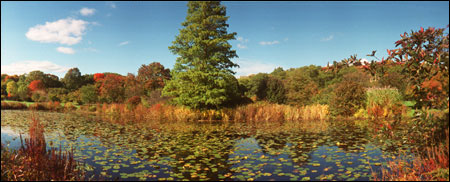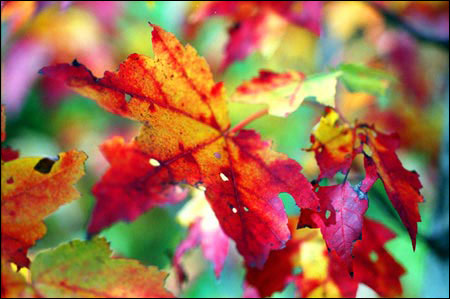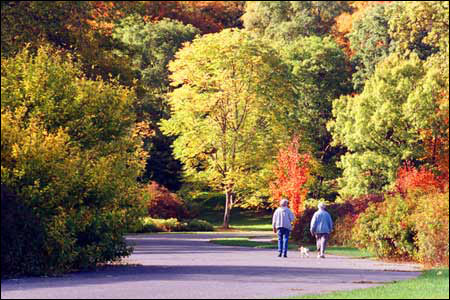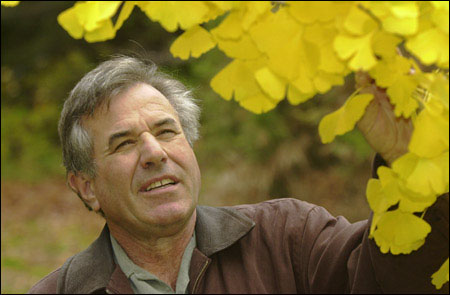Research and recreation coexist at Arnold Arboretum
As the Emerald Necklace changes color, research goes on

It’s a stunning late-October day in Boston’s Jamaica Plain neighborhood, and the Arnold Arboretum of Harvard University is putting on a show. Alive with walkers, joggers, cyclists, and pups straining at leashes, even on a weekday, the Arboretum dazzles visitors with an explosion of fiery foliage and a myriad of scenic vistas that showcase the genius of landscape architect Frederick Law Olmsted.

For Arboretum researcher Jianhua Li, however, the Arboretum’s 265 acres of 5,000-plus different kinds of plants provide far more than a pretty place to pedal. Li, a botanical taxonomist, gathers DNA from the Arboretum’s collection to study the evolutionary relationships between plants in eastern North America with those in eastern Asia. While much of Li’s research is conducted in the lab, it couldn’t happen without the extensive living resource of the Arboretum’s “tree zoo.”

“You need the living collections to study any kind of problem in plant development,” says Arboretum director Robert Cook. “To really understand [the biology] in a comparative way, the value of that living collection is tremendous.”
Most of its neighbors and visitors encounter the Arnold Arboretum as a stunningly beautiful urban respite, a place to admire and perhaps learn more about a vast array of flora collected from around the world. Yet to academics like Cook and Li it is an invaluable source of knowledge about the world of plants. From the taxonomy and evolutionary biology that dominate Li’s inquiry to molecular studies of plant behavior, to an assessment of the destructive impact of the hemlock woolly adelgid, the Arboretum is a lively and valuable site of academic research.
Far from being a distractive tension, the Arboretum’s recreation and research roles work exactly as its founders intended. Although the Arboretum’s primary mission is for the study of and education about woody plants, a unique lease with the City of Boston Parks Department guarantees that the Arboretum simultaneously serves a nonacademic public as an outdoor museum, always open and free.

“What is basically a research collection is managed in such a way that it is open to the enjoyment of the public,” says Cook, adding that Olmsted, who designed the Arboretum in close collaboration with original director Charles Sprague Sargent, was dubious at first that the two purposes could exist in concert.
Founded in 1872, the Arnold Arboretum is the nation’s oldest scientific arboretum and, like many Harvard institutions, its longevity is significant to its value: the Arboretum has data records on plants that date back to its founding. Under Sargent, the Arboretum established an early interest in the plants of East Asia – a region climatically similar to Boston – and comparisons of the flora of the two regions have run through the Arboretum’s long history, right up to Li’s research today.

The majority of the Arboretum’s visitors – estimated at about 250,000 per year – are unaware of the higher scientific purpose the facility serves. “Most people appreciate it as just a beautiful place to come,” says Peter Del Tredici, senior research scientist.
Upcoming events at the Arnold Arboretum of Harvard University
Free public walking tours
- Nov. 7, 1 p.m.
- Nov. 13, 10:30 a.m.
- Nov. 17, 12:15 p.m.
- Nov. 21, 1 p.m.No preregistration necessary; meet on the front steps of the Hunnewell Building. For information or cancellations due to inclement weather, call (617) 524-1718, ext. 100.
- Nov. 9, 7 p.m.
‘The Management Plan for Hemlock Hill’: a talk by Arboretum senior scientist Peter Del Tredici, Hunnewell Building
Between dog walkers and doctoral researchers, the Arboretum serves a hefty middle ground with its public education and horticultural initiatives. (See sidebar for a list of upcoming public events.) Fifth-graders from the Boston Public Schools, for example, study the impact of the woolly adelgid on the Arboretum’s hemlock collection as part of their curriculum on populations and ecosystems.
“They witness this very, very rapid, dramatic change on Hemlock Hill, and the students really get it,” says Deputy Director Richard Schulhof. “I think what they respond to is the authenticity of the situation.”
And Cook notes that the Arboretum’s horticultural role in bringing far-flung flora to the nation’s garden centers and backyards has been significant. He points to the Metasequoia, or dawn redwood, that graces the institution’s logo. It was thought to be extinct until it was discovered in central China in 1941. Shortly after, an Arboretum expedition brought seeds back to the United States and shipped them to botanical institutions around the world.
“Today in China, it’s relatively rare,” says Cook. “On the other hand, you can go down to Home Depot and buy it for 15 bucks.”




